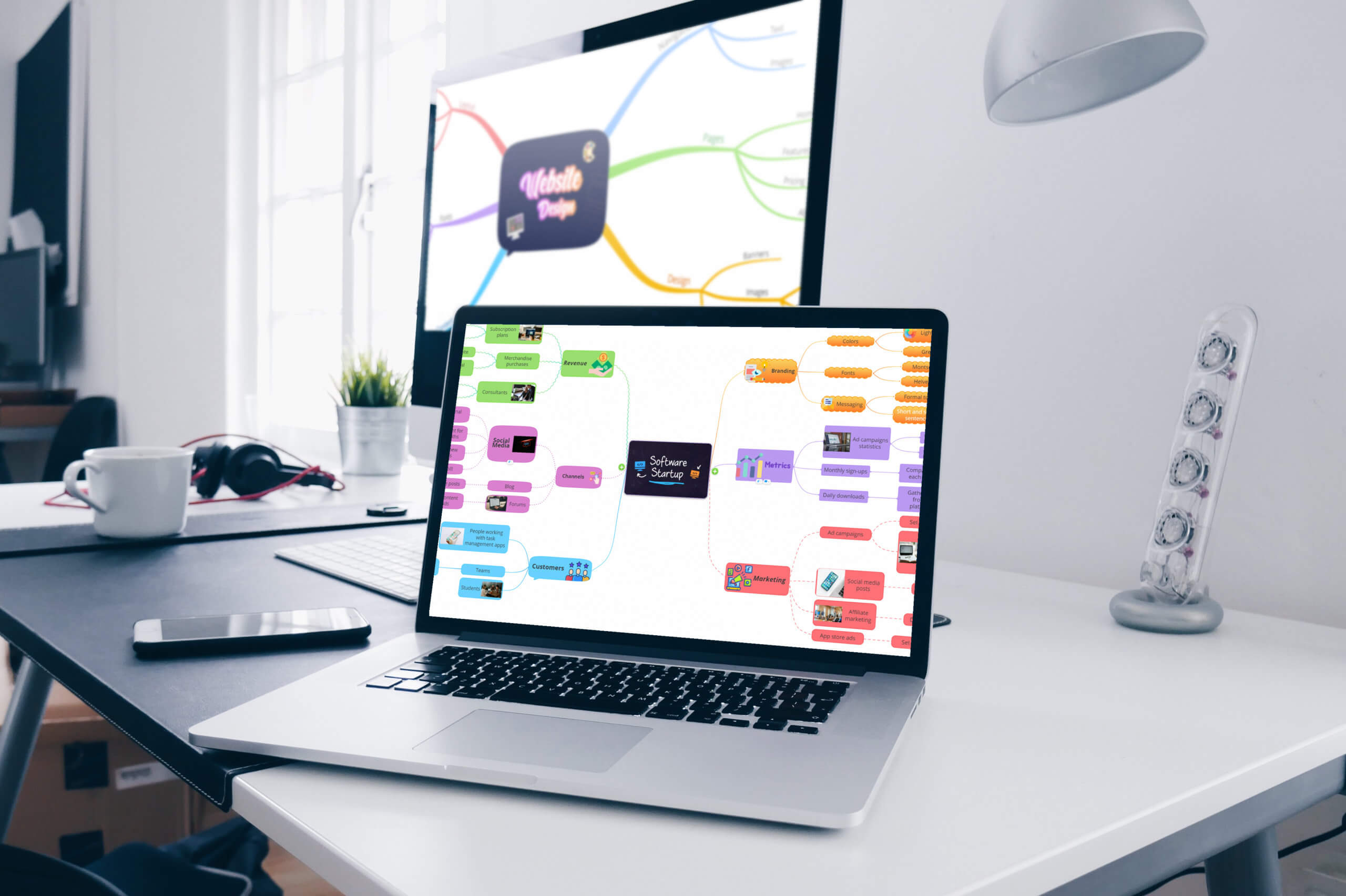February 9, 2022 (Updated February 11th, 2025)
From paper to iMindMap to AI – the continued evolution of mind mapping

Mind maps, mind maps, mind maps. Sometimes known as a brainstorm or spider diagrams, the mind map is one of the world’s most famous visual thinking tools. Whether you’re familiar with the term or not, you’ve more than likely created something like a mind map to generate ideas at some point in your life. From school to the workplace, mind maps are used all around the globe to help generate ideas.
The beauty of the mind map lies in its universality. By mirroring the natural thinking processes of the human brain, they enable both individuals and collaborative groups to get creative, inspired and come up with everything from innovative, new ideas to novel solutions to tricky problems.
So how do they actually work? Well, in the simplest terms, mind maps begin with a central idea from which related ideas can grow and radiate outwards. These branches are used to map out related ideas and, in turn, spark new thoughts and considerations that can then be added to the map, too. Utilised correctly, mind mapping can unlock incredible, world-changing ideas. In an era where automation looks set to change the nature of the working world, with creativity named the top business skill post-covid, mind maps are as important as ever for providing people with a tool of creative extraction.
But where did it all begin? We’re going to take you on a whirlwind tour on the development of the mind map, from its analogue beginning, through to its first digital incarnation in iMindMap, right through today where – via Ayoa – it is powered not only by technology but artificial intelligence itself. Keep reading to find out more.
With pen and paper
Once upon a time, in the pre-digital era, mind maps were always drawn by hand. Just like taking notes with a pen and paper, people would draw their mind maps out in notepads or on blank paper and then extract their best ideas from there. Of course, mind mapping by hand can still be a quick and handy tool that many still utilize today. The difference, these days, however, is that people have the option to replicate the process digitally. The beauty of this is that individuals are empowered to have the best of both worlds. In the same way you might note down a few quick ideas by hand but turn to a proper suite of documents for a bigger project, the modern application of mind mapping can be done by both hand and digitally.
The creation of iMindMap
So what came next? The mind map naturally had to progress into the world of software and computers. But who could recreate the most crucial aspects of mind mapping by hand – the visuality, speed and flexibility – in a new format? Well, the happy answer was a collaboration between tech entrepreneur and trailblazing creativity expert, Chris Griffiths, who worked with Tony Buzan, inventor of the Buzan mind mapping technique, to create iMindMap – a mind mapping piece of software which allowed users to recreate the classic mind map via desktop software. With new additions to the original mind map form like presentation mode, iMindMap played a crucial role in the evolution and professionalisation of the mind map technique, making it a mainstay of both personal and professional use. Still, as more and more software became cloud-based, and with an increasing demand for easy collaboration in the workplace, the mind map was set to evolve even further. Keep reading to find out more about the most recent addition to the world of mind mapping.
Innovative, flexible and powered by AI
The next stage in mind mapping evolution can be summed up in one word: Ayoa. Ayoa is the cloud-based software creation of innovation geniuses OpenGenius. Helmed by CEO Chris Griffiths, Ayoa builds upon the solid foundations laid by iMindMap, providing a multi-purpose tool for a panoramic work life cycle. From capturing the first sparks of an idea, right through to both the minute and marco management of a project, Ayoa enables users to not only generate ideas but easily action and present them to others with the addition of both project management and digital whiteboards alongside mind maps. Plus, the crucial addition of live collaboration is an essential element of the evolved mind mapping process in our new age of remote work and global connection.
The beauty of Ayoa’s digital foundation is that it allows for the continual evolution of mind mapping in a single visual, creative space. OpenGenius’ developers are always hard at work improving Ayoa to make it the best it can be. The most recent addition is perhaps the coolest yet, breaking the AI ceiling for the world of mind maps, fusing together the fastest-growing technology alongside human creativity.
At the end of the day, mind maps work in the same way our brains do. There is no such thing as a truly new thing (have you ever tried imagining a new colour?) instead, creativity is the fusion of other ideas and elements turned into something new. Mind maps work by fuelling our ideas so that we can leap between them like frogs on lily pads until we reach the right one. The addition of AI in Ayoa therefore provides more ideas, answers to questions, and other suggestions so that you can get to breakthrough moments with greater speed and increased efficiency.
With the support of AI ready to go at any time, you can be a part of the Ayoa’s new frontiers of modern mind mapping today – simply click here to find out more.

The all-in-one remote work toolkit
Ayoa is an all-in-one platform that allows teams to collaborate seamlessly while working from home. Integrations with Dropbox and Google Drive allow you to stay productive and avoid switching between apps.
Try it for free
